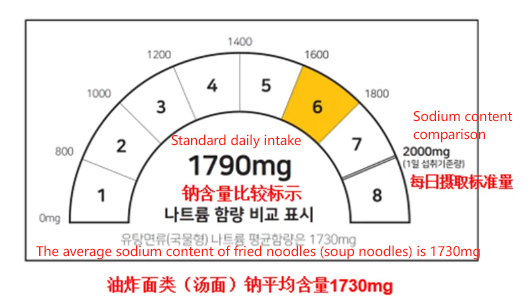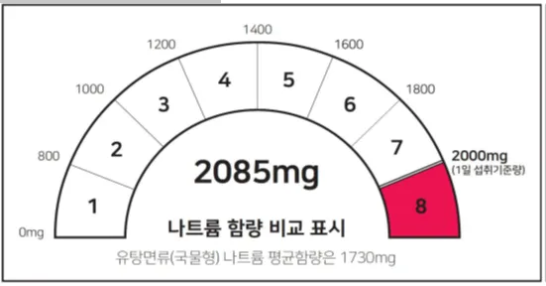The Standard and Method for Comparative Labeling of Sodium Content (hereinafter referred to as the Comparative Labeling Act of Sodium Content) is the world’s first regulation that requires the labeling of sodium content. This article will briefly introduce the Comparative Labeling Act of Sodium Content from three aspects: the target foods, the labeling standard and the labeling method.
Target foods
Table 1 Detailed classification of target foods subject to comparative of sodium content

Marking standard
1. Noodles, cold noodles, fried noodles class contained in seasoning foods
(1) Noodles (soup noodles) : 1640 mg
(2) Noodles (non-soup noodles) :1230 mg
(3) Cold noodles (soup noodles) : 1520 mg
(4) Cold noodles (non-soup noodles) :1160 mg
(5) Fried noodles (soup) :1730 mg
(6) Fried noodles (non-soup noodles) :1140 mg
2. Hamburgers, sandwiches in instant foods
(1) Ready-to-eat food (hamburger) : 1220 mg
(2) Ready-to-eat food (sandwich) : 730 mg
Labeling method
1. Marking grade ranges and an example
Sodium content is divided into 8 grades in the Comparative Labeling Act of Sodium Content, please refer to Table 2. The marking pattern requires that the border color be black, the background color be white, and the sodium content area be yellow, please refer to Fig 1 for examples.
Table 2 Grade range of comparative labeling of sodium content


Figure 1. Example of labeling of sodium content
2. Labeling requirements in the regulations:
(1) It should be marked on the main display surface or information marking surface or QR two-dimensional code form for labeling (two-dimensional code form of labeling is limited to the wrapping paper area less than 50 square centimeters);
(2) Distinguish the sodium content units of each interval, in which 0 and 2000 are marked with "mg", and the other 800, 1000, 1200, 1400, 1600, 1800 cannot be identified;
(3) Font requirements: the minimum font in the logo pattern should be larger than 6 pounds, the sodium content font should be 1 pound larger than the minimum font, and the bold logo. "Standard daily intake", "comparative labeling of sodium content", "grade range number" should be bolded;
(4) The border color is black, the background color is white, the corresponding part of the sodium content is yellow, and the 2000 mg dividing line is two black lines. When the sodium content exceeds 2,000 mg, the portion corresponding to the sodium content is displayed in red. (See Figure 2)

Figure 2. Example of labeling pattern when sodium content exceeds 2000 mg
Summary
Korea's Comparative Labeling Act of Sodium Content is currently the world's only relevant regulations on sodium content labeling, in 2015, the revised version of the Food Safety Law proposed this concept has caused a lot of controversy in South Korea, the Korean food industry said that the regulation has hasty legislation, unclear legal effect and other problems. However, after several revisions and improvements from 2015 to now, although there are still shortcomings, and the revised labeling pattern has been made more concise and easier for consumers to read.
Source: Antion
Note: This article is compiled by Antion, please indicate our source if reprint it.